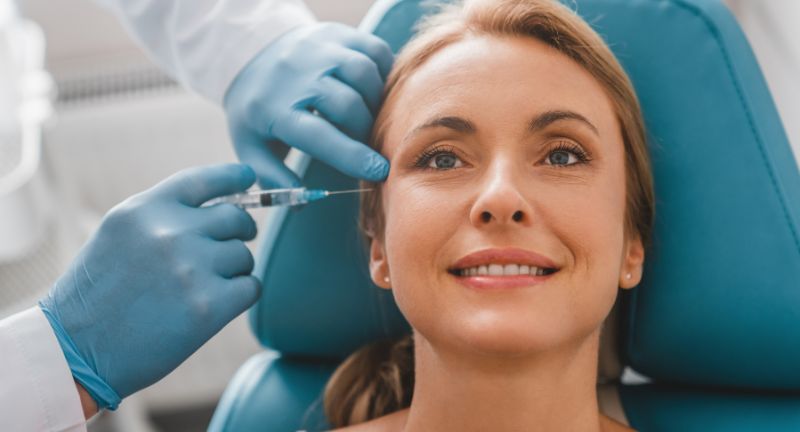NEWS
21 Mistakes to Avoid Immediately After Botox
Published
2 months agoon

Shutterstock
Botox is a popular cosmetic procedure known for reducing wrinkles and fine lines, but to maximize its benefits, certain precautions are essential immediately after treatment. Many people are unaware of what actions might interfere with the results or increase the risk of side effects. By avoiding specific activities and habits, you can ensure the longevity and effectiveness of your Botox treatment. Here are 21 things to avoid doing right after Botox.
Rubbing the Treated Area

Shutterstock
Avoid touching or rubbing the injection site for at least 24 hours. Doing so can cause the Botox to migrate to unintended areas, leading to uneven results or complications. Gentle handling of your face ensures that the Botox stays precisely where it was injected. Allow time for the product to settle into the targeted muscles effectively.
Exercising Strenuously

Shutterstock
Engaging in intense workouts can increase blood flow, which may affect how the Botox settles. Avoid strenuous physical activity for at least 24-48 hours after your treatment. This precaution reduces the risk of swelling, bruising, and uneven results. Light walking is fine, but keep workouts light until your doctor clears you.
Lying Down Too Soon

Shutterstock
Refrain from lying down for at least four hours after your Botox procedure. This helps prevent the Botox from shifting away from the intended injection sites. Staying upright minimizes complications such as drooping eyelids. Use this time to stay productive or enjoy light activities that keep you in an upright position.
Applying Makeup Immediately

Shutterstock
Putting on makeup right after Botox can irritate the skin or introduce bacteria into the injection sites. It’s best to avoid makeup for at least 24 hours to allow the skin to heal. If you must wear makeup, apply it gently to avoid pressing on the treated areas. Let your skin breathe for optimal healing and results.
Drinking Alcohol

Shutterstock
Alcohol consumption after Botox can increase the likelihood of bruising and swelling. It’s recommended to avoid alcohol for at least 24 hours post-treatment. Staying hydrated and alcohol-free aids the recovery process and reduces the chances of unwanted side effects. Choose water or non-alcoholic drinks to support your body as it adjusts.
Skipping Sunscreen

Shutterstock
Protecting your skin from the sun is crucial, especially after Botox. UV rays can irritate sensitive skin and exacerbate redness or swelling. Apply a broad-spectrum sunscreen and avoid prolonged sun exposure to ensure your skin heals properly. A hat or umbrella can provide added protection while outdoors.
Taking Blood-Thinning Medications

Shutterstock
Medications like aspirin or ibuprofen can increase the risk of bruising after Botox. If possible, avoid these drugs for a few days before and after your appointment. Always consult your doctor before stopping any prescribed medications. Stick to alternatives like acetaminophen if pain relief is necessary.
Using Harsh Skincare Products

Shutterstock
Strong skincare products like retinol or exfoliating acids can irritate the skin post-Botox. Switch to gentle, fragrance-free products for at least a week after treatment. This helps your skin recover without added stress. Consult your dermatologist for product recommendations tailored to your post-treatment needs.
Skipping Your Follow-Up Appointment

Shutterstock
A follow-up appointment ensures your Botox treatment worked as intended. Your doctor can address any concerns or make necessary adjustments during this visit. Skipping this step might leave you with less-than-ideal results. Schedule and attend your follow-up to maintain optimal outcomes.
Smoking

Shutterstock
Smoking can impair your skin’s ability to heal and reduce the effectiveness of Botox. The toxins in cigarettes may interfere with the treatment’s results. Avoid smoking for at least 24-48 hours post-injection to support your skin’s recovery. Better yet, consider quitting altogether for healthier skin overall.
Wearing Tight Headgear

Shutterstock
Tight headbands or hats can place pressure on the treated areas, potentially affecting Botox placement. Avoid wearing anything snug around your forehead or temples for at least 24 hours. Loose-fitting accessories are a safer choice during the initial recovery phase. Allow your skin to remain undisturbed for the best results.
Getting a Facial

Shutterstock
Facials and other skin treatments should be avoided for at least 24-48 hours after Botox. These procedures may interfere with the settling process or irritate the injection sites. Consult your provider before scheduling any post-Botox skin treatments. A waiting period ensures optimal healing and results.
Using Saunas or Hot Tubs

Shutterstock
Exposing yourself to high temperatures from saunas, hot tubs, or steam rooms can increase swelling and redness after Botox. The heat may also cause the Botox to spread, potentially leading to unintended results. Avoid these environments for at least 48 hours to ensure proper settling of the treatment. Opt for cooler, relaxing activities instead during the recovery period.
Sleeping Face Down

Shutterstock
Sleeping face down can place pressure on the treated areas and affect the distribution of Botox. To protect your results, sleep on your back with your head slightly elevated for the first night after treatment. This position reduces swelling and prevents Botox from migrating. Consider using pillows to support your posture if needed.
Flying Right After Botox

Shutterstock
Flying immediately after Botox is not recommended, as cabin pressure and changes in altitude can exacerbate swelling. Ideally, wait at least 24-48 hours before boarding a flight to allow the treatment to settle. This precaution minimizes the risk of uneven results and discomfort. Always consult your provider if travel is unavoidable.
Skipping Hydration

Shutterstock
Staying hydrated after Botox is crucial for your skin’s recovery. Proper hydration supports skin elasticity and promotes healing at the injection sites. Drink plenty of water and avoid dehydrating beverages like caffeinated drinks or alcohol. Hydrated skin responds better to Botox, helping you achieve optimal results.
Neglecting Ice Packs for Swelling

Shutterstock
If you experience mild swelling or redness, applying a cold compress or ice pack can help reduce these effects. However, ensure you do not apply ice directly to the skin to avoid irritation. Wrap the ice pack in a cloth and use it intermittently for relief. Cooling the area can also provide comfort after treatment.
Ignore Bruising

Shutterstock
Bruising can occasionally occur after Botox, but ignoring severe or prolonged bruising isn’t wise. If you notice unusual discoloration or persistent pain, contact your provider for advice. Most mild bruises resolve within a few days, but any unusual signs should be addressed promptly. Early intervention ensures a smooth recovery.
Delaying Post-Treatment Care Questions

Shutterstock
If you have questions or concerns about your Botox treatment, don’t hesitate to ask your provider. Delaying your concerns may lead to preventable issues or dissatisfaction with your results. Open communication with your practitioner ensures you’re informed about aftercare and what to expect. A proactive approach helps you feel confident and well-prepared.
Participating in Intense Facial Expressions

Shutterstock
Exaggerated facial movements, like frowning or squinting, can affect how Botox settles in the muscles. Avoid intense expressions for the first 24 hours to allow the treatment to work effectively. Resting your facial muscles supports the smooth and even distribution of Botox. Relax and let the product do its job without interference.
Rushing into Additional Treatments

Shutterstock
If you’re considering other cosmetic procedures, wait until your Botox has fully settled before proceeding. This typically takes about 1-2 weeks. Rushing into additional treatments could interfere with the results or healing process. Always consult your provider for guidance on scheduling complementary procedures.
Skipping the Icebreaker Period

Shutterstock
Patience is key after Botox, as the full effects may take up to two weeks to appear. Don’t expect immediate results or become concerned if changes aren’t noticeable right away. Allow the treatment to integrate fully into your facial muscles. Relax and trust the process for the best long-term results.
Conclusion

Shutterstock
Avoiding certain activities after Botox is crucial to achieving the best results and minimizing side effects. Simple precautions like avoiding exercise, alcohol, and harsh skincare products can make a significant difference in your recovery. By following your provider’s instructions and giving your skin time to heal, you can enjoy smooth and youthful results. Remember, patience and care are key to making the most of your Botox treatment.
Related Topics:

More From Lifestylogy
-


27 Habits To Implement That Could Change Your Life For…
-


25 Civil War-Era Survival Foods Preppers Can Still Make Today
-


21 Warning Signs Your Teen May Be Struggling with Their…
-


25 Ways to Tell You’re Raising a Dandelion Child
-


20+ Things Online Shoppers Regret Buying Within Days
-


23 Crucial Items Often Overlooked In Wills—Don’t Miss These
-


20 Things People Mindlessly Spend Their Money On That Might…
-


25 Things In Your Home That Guests Might Secretly Judge
-


25 Signs You’re Married to a Kind Man, But Useless…